Every March, most college basketball fans tune into a steady stream of NCAA basketball tournament games until a champion is crowned. This report, based on recent Consumer Insights survey data, profiles fans of men's and women's college basketball.

➤ Twenty-two percent of US internet adults watch NCAA college basketball, with 20% watching men's basketball and 9% watching women's basketball. Ten percent of internet adults in China and about 2% in Europe watch NCAA basketball.
➤ NCAA basketball viewers are heavily skewed toward college-educated males who watch live TV sports frequently (at least once a week). The majority of women's college basketball viewers are men.
➤ The vast majority of NCAA college basketball viewers watch games on TV, with only about 10% attending games in person. Four in 10 college basketball viewers watch game highlights online, with about 10% placing bets on college basketball games.

Data profiling college basketball viewers was collected from the S&P Global Market Intelligence Kagan US third-quarter 2023 and first-quarter 2024 Consumer Insights surveys. The surveys found that 17% of internet adults reported watching NCAA men's college basketball last fall, increasing to 20% during the lead up to March Madness 2024. In addition, the fall 2023 survey found that 7% of internet adults watched women's college basketball, increasing to 9% in March 2024. Among those watching women's NCAA college basketball, 78% also watch men's NCAA college basketball games. Approximately one-third (36%) of those watching NCAA men's college basketball also watch women's college basketball games.
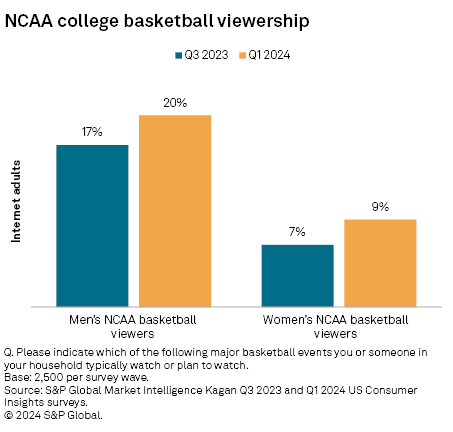
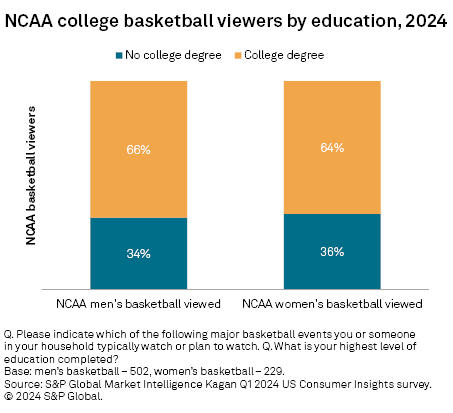
The age distribution of men's and women's college basketball viewers is very similar. About 20% of those watching NCAA men's or women's college basketball are young adults under 35 years of age. One-third of viewers are typically in the 35-54 age bracket, and about 45% are adults over 55 years of age. Seven out of 10 (70%) of NCAA men's basketball viewers and 62% of NCAA women's basketball viewers are men.
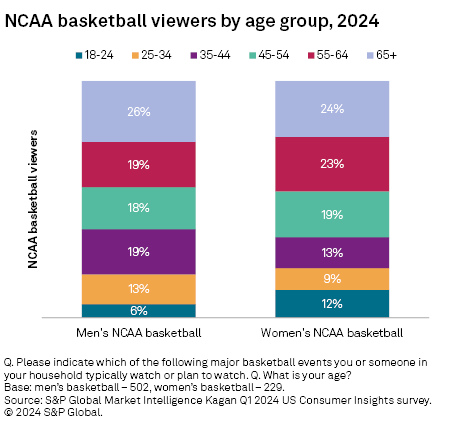
The survey found that college basketball viewing is heavily reliant on traditional and virtual multichannel TV services. For instance, over 60% of those watching NCAA college basketball subscribe to a traditional multichannel TV service from a cable, satellite or telco service provider. Approximately 30% of college basketball fans have dropped their traditional pay TV service (video cord cutters), and less than 10% have never subscribed to a traditional pay TV service (video cord nevers). Among video cord cutters watching men's college basketball, 53% reported subscribing to a virtual online pay TV service, such as Sling TV or YouTube TV. Among video cord-never households, 30% subscribe to a virtual online pay TV service.
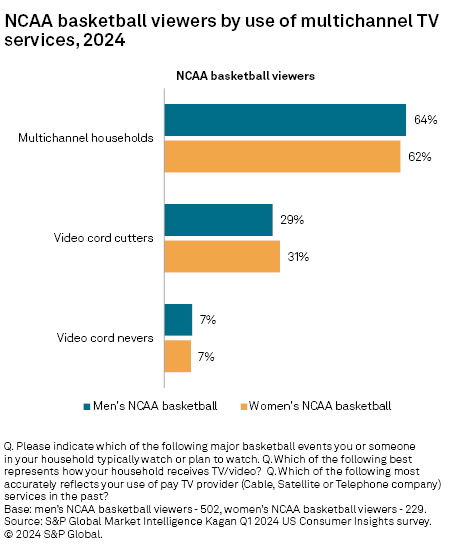
The survey data shows that the vast majority of NCAA basketball viewers tend to watch live TV sports at least once a week (frequent viewers). Approximately two-thirds (64%) of those watching NCAA men's basketball and 72% of those watching NCAA women's basketball view live TV sports either daily or multiple times each week. The NCAA March Madness tournament is likely to attract college basketball viewers who are frequent live sports viewers, as well as infrequent live sports viewers (those watching live TV sports less than once a week). Many of the college basketball viewers who have not watched live TV sports over the past three months (3%) may also be watching tournament games.
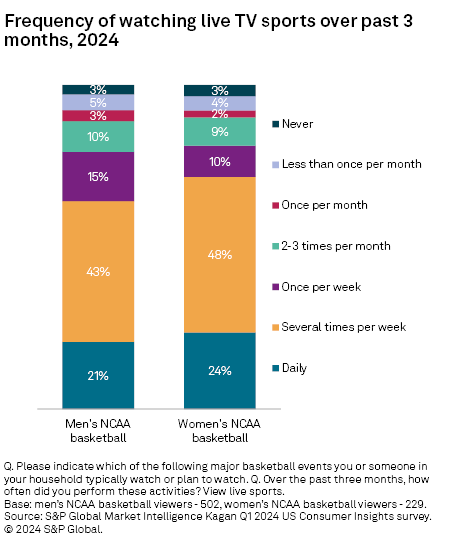
In our recently completed first-quarter 2024 US Consumer Insights survey, we asked NCAA basketball viewers about a variety of men's and women's college basketball-related activities they have performed. The data shows that, overwhelmingly, college basketball is a TV viewing event, with 80% reporting they watch men's basketball and 69% watching women's basketball on TV. A very small percentage of college basketball fans attend live games. About 40% indicated they watch highlights or video clips online, and less than 20% listen to college basketball-related podcasts. About 10% said they interact online with a player or team, place bets on college basketball games and buy merchandise related to college basketball.
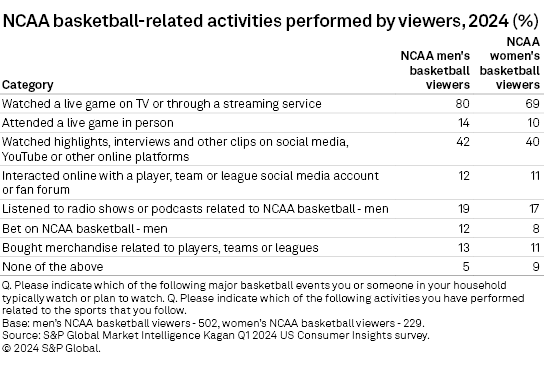
In addition to March Madness being a premiere sports event in the US, NCAA college basketball has an international following. Among markets outside of the US surveyed by Kagan, China is by far the largest with 10% of internet adults watching NCAA men's basketball and 7% watching women's college basketball. In Europe, NCAA college basketball has a modest following, ranging from 3% of surveyed internet adults in Italy to 1% in the UK.

Please join S&P Global's Mike Reynolds, Justin Nielson and Scott Robson in a webinar April 3, 2024, discussing critical issues such as the increasing cost and evolving business model of global and local sports rights, the state of regional sports networks, and growth of sports direct-to-consumer services.
The Kagan third-quarter 2023 and first-quarter 2024 US Consumer Insights surveys were conducted during September 2023 and March 2024, consisting of 2,500 internet adults per survey wave. The surveys have a margin of error of +/- 1.9 percentage points at the 95% confidence level. The Kagan 2023 European Consumer Insights survey was conducted during December 2023, consisting of 1,000 internet adults per country in the UK, France, Germany, Italy, Sweden and Poland. Each survey has a margin of error of +/-3 percentage points at the 95% confidence level. The Kagan 2023 Asia Consumer Insights survey was conducted during June 2023, consisting of 1,000 internet adults per country in China, South Korea and India. Each survey has a margin of error of +/3 percentage points at the 95% confidence level. Percentages are rounded to the nearest whole number. Survey data should only be used to identify general market characteristics and directional trends.
To submit direct feedback/suggestions on the questions presented here, please use the "feedback" button located above, directly under the title of this article. Note that while all submissions will be reviewed and every attempt will be made to provide pertinent data, Kagan is unable to guarantee inclusion of specific questions in future surveys.
Consumer Insights is a regular feature from S&P Global Market Intelligence Kagan.
This article was published by S&P Global Market Intelligence and not by S&P Global Ratings, which is a separately managed division of S&P Global.



